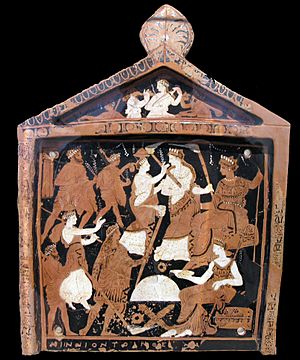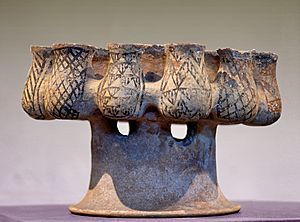Kernos facts for kids

The kernos (say: KER-nos) was a special type of pottery vessel used in ancient Greece. It looked like a ring or a stone tray with several small bowls attached to it. People used these bowls to hold different kinds of offerings. These offerings were usually given to gods and goddesses during religious ceremonies.
Ancient writings describe the kernos and list the special items it might contain. The kernos was mainly used in the religious practices of Demeter and Persephone, and also of Cybele and Attis.
This type of vessel first appeared in the Neolithic period, which was a very early time in human history. It was made of stone around 3000 BC, during the first stages of the Minoan civilization. Kernoi were also made in Minoan pottery and Cycladic pottery. They continued to be made throughout the time of ancient Greek pottery. One of the oldest known Old Latin texts, called the Duenos inscription, is written around a kernos that has three linked pots. This kernos is from an Etruscan style.
Sometimes, the word "kernos" is also used for similar vessels found in other ancient cultures. These cultures were located around the Mediterranean Sea, in the Levant (a region in the Middle East), Mesopotamia, and South Asia.
What Was Inside a Kernos?
An ancient writer named Athenaeus wrote down a description of the kernos. He said it was:
a terracotta vessel with many little bowls stuck on to it. In them there is sage, white poppy heads, wheat, barley, peas (?), vetches (?), pulse, lentils, beans, spelt (?), oats, cakes of compressed fruit, honey, olive oil, wine, milk, and unwashed sheep's wool. When one has carried this vessel, like a liknophoros, he tastes of the contents.
This description tells us that the small bowls on a kernos held many different kinds of food and natural items. These included grains like wheat and barley, beans, lentils, and even poppy heads. There were also liquids like honey, olive oil, wine, and milk. Sometimes, unwashed sheep's wool was also placed in the bowls. After carrying the kernos, people would taste what was inside.
How Was the Kernos Used?
The kernos played an important role in ancient religious ceremonies. It was often carried in a procession, which is like a parade, during the Eleusinian Mysteries. The Eleusinian Mysteries were secret religious rituals dedicated to the goddesses Demeter and Persephone.
During these ceremonies, a priestess would carry the kernos on top of her head. Ancient artworks show this practice. Sometimes, if the kernos was not being carried, a lamp might be placed in its middle. This would make the kernos a source of light during the rituals.
See also
 In Spanish: Cerno para niños
In Spanish: Cerno para niños


